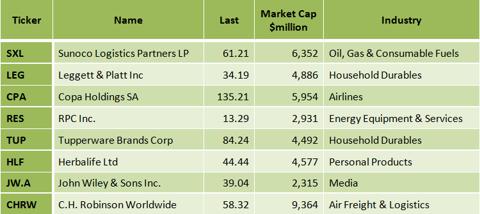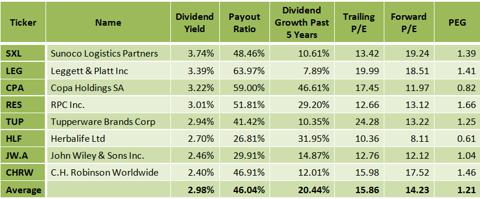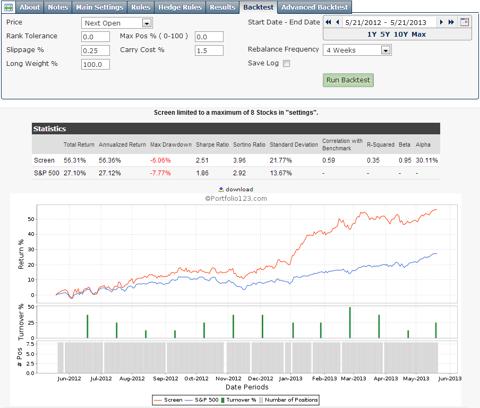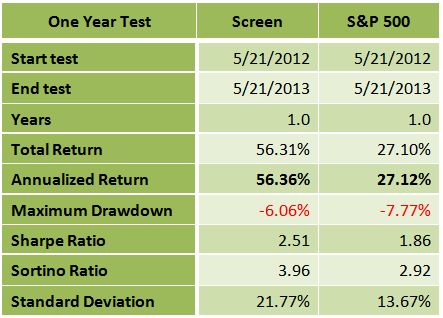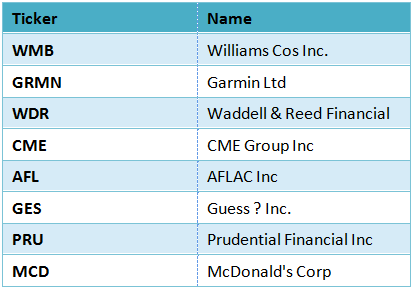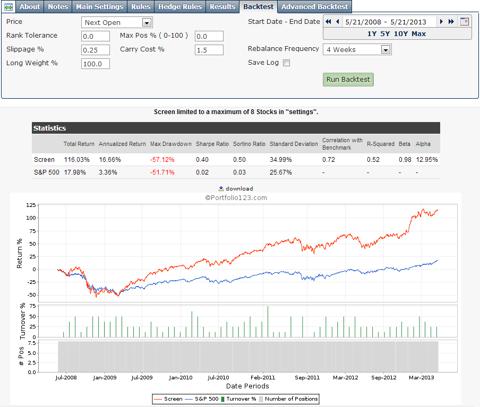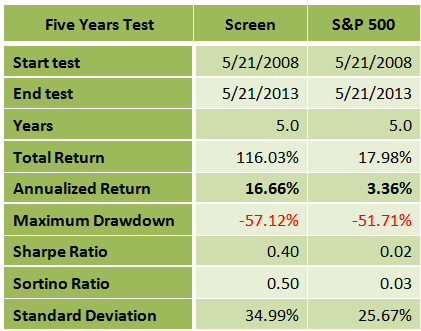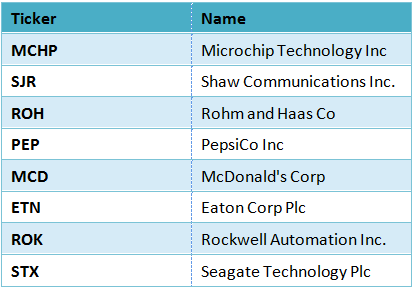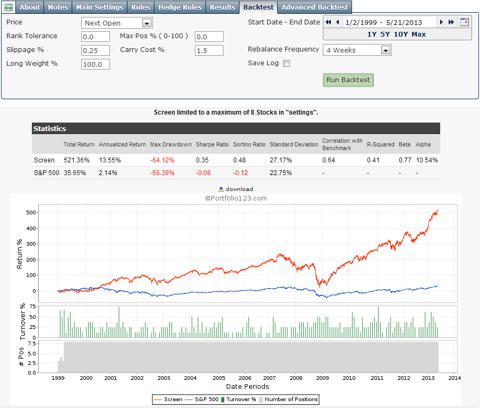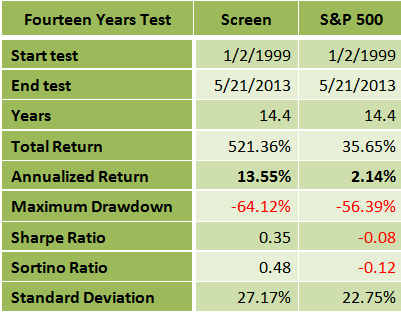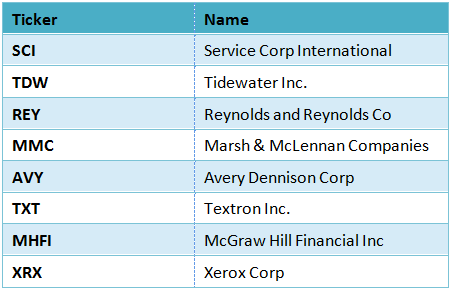"History must repeat itself because we pay such little attention to it the first time." (Blackie Sherrod, sportswriter born 1919 and still "kicking")
On April 8th, we learned that General Electric (GE) would be acquiring Lufkin Industries (LUFK). The deal is one of the three largest in the oilfield machinery and equipment industry during the past decade, and sets the stage for further acquisitions in this sector. Investors should start considering which companies might be next.
Bloomberg had been saying since September 2012 that LUFK was a takeover target when its stock had fallen to the lowest price in 3 years. "Lufkin will more than double GE's share of the artificial lift segment and give it about 15 percent market share," Julian Mitchell, an analyst at Credit Suisse in New York wrote in a note to clients.
Top Machinery Companies To Watch In Right Now: Danaher Corp (DHR)
Danaher Corporation (Danaher) designs, manufactures and markets professional, medical, industrial and commercial products and services. The Company�� research and development, manufacturing, sales, distribution, service and administrative facilities are located in more than 50 countries. It operates in five segments: Test & Measurement; Environmental; Life Sciences & Diagnostics; Dental; and Industrial Technologies. In April 2011, the Company sold its Pacific Scientific Aerospace (PSA) business. On June 30, 2011, the Company acquired Beckman Coulter, Inc. (Beckman Coulter). In January 2012, the Company sold its Accu-Sort businesses. In February 2012, the Company sold its Kollmorgen Electro-Optical (KEO) business. During the year ended December 31, 2011, the Company acquired EskoArtwork, On February 6, 2012, L-3 Communications Holdings, Inc. acquired Kollmorgen Electro-Optical unit of the Company. In January 2013, the Company acquired Navman Wireless.
TEST & MEASUREMENT
The Company�� Test & Measurement segment is a provider of electronic measurement instruments and monitoring, management and optimization tools for communications and enterprise networks and related services. The segment�� products are used in the design, development, manufacture, installation, deployment and operation of electronics equipment and communications networks and services. Customers for these products and services include manufacturers of electronic instruments; service, installation and maintenance professionals; manufacturers who design, develop, manufacture and install network equipment, and service providers who implement, maintain and manage communications networks and services.
The Company�� business designs, manufactures, and markets a variety of compact professional test tools, thermal imaging and calibration equipment for electrical, industrial, electronic and calibration applications. These test products measure voltage, current, resistance, power quality, frequency, p! ressure, temperature and air quality. Typical users of these products include electrical engineers, electricians, electronic technicians, medical technicians, and industrial maintenance professionals. Its business also offers general purpose test products and video test, measurement and monitoring products used in electronic design, manufacturing and advanced technology development. The business��general purpose test products, including oscilloscopes, logic analyzers, signal sources and spectrum analyzers, are used to capture, display and analyze streams of electrical data. The Company sells these products into a variety of industries with electronic content, including the communications, computer, consumer electronics, education, military/aerospace and semiconductor industries.
Typical users include research and development engineers who use its general purpose test products to design, de-bug, monitor and validate the function and performance of electronic components, subassemblies and end-products. Its video test products include waveform monitors, video signal generators, compressed digital video test products and other test and measurement equipment used to enhance a viewer�� video experience. Typical users of these products include video equipment manufacturers, content developers and traditional television broadcasters. Products in this business are marketed under the FLUKE, TEKTRONIX, KEITHLEY, RAYTEK, FLUKE BIOMEDICAL, AMPROBE and MAXTEK brands.
The communications businesses offer network management solutions, handheld and fixed diagnostic equipment and security solutions, as well as related installation and maintenance services, for a range of private network applications, as well fixed and mobile communications systems. Typical users of the business��products include network engineers, installers, operators, and technicians. Its network management tools help network operators continuously manage network performance and optimize the utilization, uptime and servi! ce qualit! y of the network. Products in this business are marketed under the TEKTRONIX, FLUKE NETWORKS, ARBOR, VISUAL NETWORKS and AIRMAGNET brands.
Matco Tools manufactures and distributes professional tools, toolboxes and automotive equipment through independent mobile distributors, who sell primarily to professional mechanics under the MATCO brand. Hennessy Industries is a North American full-line wheel service equipment manufacturer, providing brake lathes, vehicle lifts, tire changers, wheel balancers, and wheel weights under the AMMCO, BADA and COATS brands. Typical users of these products are automotive tire and repair shops. Sales are generally made through its direct sales personnel, independent distributors, retailers, and original equipment manufacturers.
ENVIRONMENTAL
The Company�� Environmental segment provides products that help protect its water supply and air quality and serves two primary markets: water quality and retail/commercial petroleum. Danaher�� water quality business is engaged in water quality analysis and treatment, providing instrumentation and disinfection systems to help analyze and manage the quality of ultra pure, potable and waste water in residential, commercial, industrial and natural resource applications. Its water quality operations design, manufacture and market a range of analytical instruments, related consumables, and associated services that detect and measure chemical, physical, and microbiological parameters in ultra pure, potable and waste water as well as groundwater and ocean bodies; ultraviolet disinfection systems, which disinfect billions of gallons of municipal, industrial and consumer water every day in more than 35 countries, and industrial water treatment solutions, including chemical treatment solutions intended to address corrosion, scaling and biological growth problems in boiler, cooling water and industrial waste water applications, as well as associated analytical services. Typical users of its analytical in! struments! , ultraviolet disinfection systems, industrial water treatment solutions and related consumables and services include professionals in municipal drinking water and waste water treatment plants and industrial process water and waste water treatment facilities, third-party testing laboratories and environmental field operations. Its water quality business provides products under a variety of well-known brands, including HACH, HACH/LANGE, TROJAN TECHNOLOGIES and CHEMTREAT. Manufacturing facilities are located in North America, Europe, and Asia.
The Company has served the retail/commercial petroleum market through its Veeder-Root business. Gilbarco Veeder-Root is a provider of products and services for the retail/commercial petroleum market, including environmental monitoring and leak detection systems; vapor recovery equipment; fuel dispensers; point-of-sale and secure electronic payment technologies for retail petroleum stations; submersible turbine pumps, and remote monitoring and outsourced fuel management services, including compliance services, fuel system maintenance, and inventory planning and supply chain support. Typical users of these products include independent and Company-owned retail petroleum stations, high-volume retailers, convenience stores, and commercial vehicle fleets. The Company markets its retail/commercial petroleum products under a variety of brands, including GILBARCO, VEEDER-ROOT, and GILBARCO AUTOTANK. Manufacturing facilities are located in North America, Europe, Asia and Latin America. Sales are generally made through independent distributors and its direct sales personnel.
LIFE SCIENCES & DIAGNOSTICS
The Company�� diagnostics businesses offer a range of analytical instruments, reagents, consumables, software and services that hospitals, physician�� offices, reference laboratories and other critical care settings use to diagnose disease and make treatment decisions. Its life sciences businesses offer a range of research and clinical ! tools tha! t are used by scientists to study cells and cell components to gain a better understanding of complex biological matters. Pharmaceutical and biotechnology companies, universities, medical schools and research institutions use these tools to study the causes of disease, identify new therapies and test new drugs and vaccines. The diagnostics business consists of its core lab, acute care and pathology diagnostics businesses.
The Company�� core lab diagnostics business is a manufacturer and marketer of biomedical testing instrument systems, tests and supplies that are used to evaluate and analyze samples made up of body fluids, cells and other substances. The information generated is used to diagnose disease, monitor and guide treatment and therapy, assist in managing chronic disease and assess patient status in the hospital, outpatient and physician office settings. Its chemistry systems use electrochemical detection and chemical reactions with patient samples to detect and quantify substances of diagnostic interest in blood and other body fluids. Commonly performed tests include glucose, cholesterol, triglycerides, electrolytes, proteins and enzymes.
The Company�� immunoassay systems also detect and quantify chemical substances of diagnostic interest in body fluids, particularly in circumstances where more specialized diagnosis is required. Commonly performed immunoassay tests assess thyroid function, screen and monitor for cancer and cardiac risk and provide important information in fertility and reproductive testing. Its cellular analysis business includes hematology, flow cytometry and coagulation products. The business��hematology systems use principles of physics, optics, electronics and chemistry to separate cells of diagnostic interest and then quantify and characterize them, allowing clinicians to study formed elements in blood (such as red and white blood cells and platelets). The business also distributes coagulation products, which rely on clotting, chromogenic! and immu! nologic technologies to provide the detailed information that clinicians require to diagnose bleeding and clotting disorders and to monitor anticoagulant therapy. It also offer systems and workflow solutions that allow laboratories to automate a number of steps from the pre-analytical through post-analytical stages including sample barcoding/information tracking, centrifugation, aliquotting, storage and conveyance. These systems along with the analyzers above are controlled through laboratory level software that enables laboratory managers to monitor samples, results and lab efficiency.
The Company�� acute care diagnostics business is a provider of instruments and related consumables and services that are used in both laboratory and point-of-care environments to rapidly measure critical parameters, including blood gases, electrolytes, metabolites and cardiac markers. Typical users of these products include hospital central laboratories, intensive care units, hospital operating rooms and hospital emergency rooms. Its pathology diagnostics business is engaged in the anatomical pathology market, offering a suite of instrumentation and related consumables used across the entire workflow of a pathology laboratory. Its pathology diagnostics products include tissue embedding, processing and slicing (microtomes) instruments and related reagents and consumables; chemical and immuno-staining instruments, reagents, antibodies and consumables; slide coverslipping and slide/cassette marking instruments, and imaging instrumentation including slide scanners, microscopes, cameras and associated software. Typical users of these products include pathologists, lab managers and researchers. Its diagnostics business generally markets its products under the BECKMAN COULTER, LEICA BIOSYSTEMS, RADIOMETER and SURGIPATH brands. Manufacturing facilities are located in North America, Europe, Asia and Australia. The businesses sell to customers primarily through direct sales personnel and to a lesser extent through ! independe! nt distributors.
The Company�� microscopy business is a provider of professional microscopes designed to manipulate, preserve and capture images of, and enhance the user�� visualization of, microscopic structures. Its microscopy products include laser scanning (confocal) microscopes; compound microscopes and related equipment; surgical and other stereo microscopes; specimen preparation products for electron microscopy; and digital image capture and manipulation equipment. The Company also offers workflow instruments and consumables that help researchers analyze genomic, protein and cellular information. Key product areas include sample preparation equipment, such as centrifugation and capillary electrophoresis instrumentation and consumables; liquid handling automation instruments and associated consumables; flow cytometry instrumentation and associated antibodies and reagents; and particle characterization instrumentation. The business also offers genome profiling services. Researchers use the business��products to study biological function in the pursuit of basic research, therapeutic and diagnostic development. Typical users of these products include pharmaceutical and biotechnology companies, universities, medical schools and research institutions and in some cases industrial manufacturers.
The Company�� mass spectrometry business is a provider of high-end mass spectrometers. Mass spectrometry is a technique for identifying, analyzing and quantifying elements, chemical compounds and biological molecules, individually or in complex mixtures. Its products utilize various combinations of quadrupole, time-of-flight and ion trap technologies, and are typically used in conjunction with a third party liquid chromatography instrument. Its mass spectrometer systems are used in numerous applications, such as drug discovery and clinical development of therapeutics as well as in basic research, clinical testing, food and beverage quality testing and environmental testing. To s! upport it! s installations around the world, it provides implementation, validation, training, maintenance and support from its global services network. Typical users of its mass spectrometry products include molecular biologists, bioanalytical chemists, toxicologists, and forensic scientists, as well as quality assurance and quality control technicians. It also provides high-performance bioanalytical measurement systems, including microplate readers, automated cellular screening products and associated reagents, and imaging software. Typical users of these products include biologists and chemists engaged in research and drug discovery, who use these products to determine electrical or chemical activity in cell samples. Its life sciences business generally markets its products under the LEICA MICROSYSTEMS, BECKMAN COULTER, AB SCIEX and MOLECULAR DEVICES brands. Manufacturing facilities are located in Europe, Australia, Asia and North America.
DENTAL
The Company�� Dental segment is a provider of a range of consumables, equipment and services for the dental market, which encompasses the diagnosis, treatment and prevention of disease and ailments of the teeth, gums and supporting bone. Its dental businesses develop, manufacture and market dental consumables and dental equipment orthodontic bracket systems and lab products; impression, bonding and restorative materials; endodontic systems and related consumables; infection prevention products, and diamond and carbide rotary instruments. Typical customers and users of these products include general dentists, dental specialists, dental hygienists, dental laboratories and other oral health professionals, as well as educational, medical and governmental entities. Its dental products are marketed primarily under the KAVO, GENDEX, iCAT, INSTRUMENTARIUM DENTAL, SOREDEX, PELTON & CRANE, DEXIS, ORMCO, KERR, PENTRON, SYBRON ENDO and TOTAL CARE brands.
INDUSTRIAL TECHNOLOGIES
The Company�� Industrial Technologies segment ! designs a! nd manufactures components and systems that are typically incorporated by original equipment manufacturers (OEMs) and systems integrators for sale into a diverse set of applications and end-markets. The businesses in this segment also provide service and support, including helping customers with integration and installation and providing services to ensure performance and up-time. Danaher�� product identification business is a global provider of equipment and consumables for variable printing, marking and coding on a variety of consumer and industrial products. Its businesses design, manufacture, and market a variety of equipment used to print bar codes, date codes, lot codes, and other information on primary and secondary packaging. Its equipment can apply alphanumeric codes, logos and graphics to a range of surfaces at a variety of line speeds, angles and locations on a product or package.
EskoArtwork, the business is a service solutions provider for the digital packaging design and production market. Typical users of the product identification business��products include food and beverage manufacturers, pharmaceutical manufacturers, retailers and commercial printing and mailing operations. Its product identification products are primarily marketed under the VIDEOJET, LINX, FOBA and ESKOARTWORK brands. Manufacturing facilities are located in North America, Europe, Latin America, and Asia. The Company is a provider of electromechanical motion control solutions for the industrial automation and packaging markets. Its businesses provide a range of products including standard and custom motors; drives; controls, and mechanical components, such as ball screws, linear bearings, clutches/brakes, and linear actuators.
The products are sold in various precision motion markets, such as the markets for packaging equipment, medical equipment, robotics, circuit board assembly equipment, elevators and electric vehicles (such as lift trucks). Its motion products are marketed under a vari! ety of br! ands, including KOLLMORGEN, THOMSON, DOVER and PORTESCAP. Manufacturing facilities are located in North America, Europe, Latin America, and Asia. Its sensors and controls products include instruments that monitor, sense and control discrete manufacturing variables such as temperature, position, quantity, level, flow and time. Users of these products span a wide variety of manufacturing markets. Certain businesses included in this group also make and sell instruments, controls and monitoring systems used by the electric utility industry to monitor their transmission and distribution systems, as well as automatic identification solutions. The products are marketed under a variety of brands, including DYNAPAR, HENGSTLER, IRIS POWER, WEST, GEMS SENSORS, SETRA and QUALITROL. Sales are generally made through our direct sales personnel and independent distributors.
The Company�� defense business designs, manufactures, and markets energetic material systems. Typical users of these products include defense systems integrators and prime contractors. defense products are typically marketed under the PACIFIC SCIENTIFIC ENERGETIC MATERIALS COMPANY brand. The KEO business designs, develops, manufactures and integrates highly engineered, stabilized electro-optical/ISR systems that integrate into submarines, surface ships and ground vehicles. Jacobs Vehicle Systems (JVS) is a supplier of supplemental braking systems for commercial vehicles, selling JAKE BRAKE brand engine retarders for class 6 through 8 vehicles and bleeder and exhaust brakes for class 2 through 7 vehicles. Customers are primarily manufacturers of class 2 through class 8 vehicles, and sales are typically made through its direct sales personnel. Manufacturing facilities of its sensors and controls, defense and JVS businesses are located in North America, Latin America, Europe and Asia.
Advisors' Opinion: - [By Kathy Kristof]
Headquarters: Washington, D.C.
52-Week High: $56.06
52-Week Low: $40.36
Annual Sales: $16.1 bill.
Projected Earnings Growth: 15% annually over the next five years
Danaher was an industrial conglomerate made up of disparate cyclical businesses. Then, in 1990, management opted to restructure to focus on five key areas in which it believed it could become a global leader.
The wisdom of the strategy proved itself in 2009 as the nation struggled with the recession precipitated by the financial crisis, says Morningstar analyst Daniel Holland. Although revenues of many of its rivals were cut in half that year, Danaher saw its sales drop about 12% and bounce back nicely in 2010. Revenues and profits have continued to rise by double-digit percentages. Second-quarter profits and sales jumped 31% and 28% respectively from the year-earlier period.
Danaher’s growth is primarily fueled by acquisitions, which it does unusually well. Danaher’s latest purchase, of Beckman Coulter last year, has not only proved profitable, it has put 40% of the company’s sales in the rapidly growing health care sector.
Top Machinery Companies To Watch In Right Now: First Majestic Silver Corp.(AG)
First Majestic Silver Corp. engages in the production, development, exploration, and acquisition of mineral properties with a focus on silver in Mexico. The company owns interests in La Encantada Silver Mine comprising 4,076 hectares of mining rights and 1,343 hectares of surface land located in Coahuila; La Parrilla Silver Mine consisting of mining concessions covering an area of 69,867 hectares; and San Martin Silver Mine comprising approximately 7,841 hectares of mineral rights and approximately 1,300 hectares of surface land rights located in Jalisco. It also holds interests in Del Toro Silver Mine consisting of 393 contiguous hectares of mining claims and an additional 129 hectares of surface rights located in Zacatecas; Real de Catorce Silver Project comprising 22 mining concessions covering 6,327 hectares located in San Luis Potosi state; and Jalisco Group of Properties consisting of mining claims totalling 5,240 hectares located in Jalisco. The company was founded in 1979 and is headquartered in Vancouver, Canada.
Advisors' Opinion: - [By Sy_Harding]
First Majestic Silver is one of the purest silver plays on the market. The company owns and operates three primary silver mines in Mexico: La Parrilla, San Martin, and La Encantada.
Shares of AG have risen more than 60% for the year.
First Majestic generates 85% of its revenue through the production and sale of silver. The rest of the company's revenue is generated through gold, lead, and zinc.
First Majestic expects to increase total silver output from its operations to 7.5 million ounces of silver in 2011, and up to 16.0 million ounces by 2014.
- [By Goodwin]
The shares closed at $88.19, down $1.1, or 1.23%, on the day. Its market capitalization is $77.08 billion. About the company: Siemens AG manufactures a wide range of industrial and consumer products. The Company builds locomotives, traffic control systems, automotive electronics, and engineers electrical power plants. Siemens also provides public and private communications networks, computers, building control systems, medical equipment, and electrical components. The Company operates worldwide.
Best Financial Stocks To Invest In 2014: AGCO Corporation (AGCO)
AGCO Corporation manufactures and distributes agricultural equipment and related replacement parts worldwide. The company provides tractors, including compact tractors for small farms and specialty agricultural industries comprising dairies, landscaping, and residential areas; utility tractors, such as two-wheel and all-wheel drive versions for small and medium-sized farms, and specialty agricultural industries consist of dairy, livestock, orchards, and vineyards; and horsepower tractors for large farms and on cattle ranches for hay production. It also offers application equipment, which includes self-propelled, three and four-wheeled vehicles, and related equipment for use in the application of liquid and dry fertilizers, and crop protection chemicals; chemical sprayer equipment for planting crops; and related equipment that comprises vehicles for waste application, as well as provides combines. In addition, the company offers hay tools and forage equipment consisting rou nd and rectangular balers, self-propelled windrowers, disc mowers, spreaders and mower conditioners for harvesting and packaging vegetative feeds; and engines, such as diesel engines, gears, and generating sets. Further, it provides implements, including disc harrows for improving field performance; heavy tillage to break up soil and mix crop residue; and field cultivators for preparing smooth seed bed and destroy weeds, as well as offers tractor-pulled planters and loaders. Additionally, the company provides precision farming technologies to enhance productivity and profitability on the farm; and other advanced technology precision farming products to gather information, such as yield data, as well as offers wholesale financing and retail financing. It markets its products under the Challenger, Fendt, Massey Ferguson, and Valtra brand names through a network of independent dealers and distributors. AGCO Corporation was founded in 1990 and is headquartered in Duluth, Georgia .
Top Machinery Companies To Watch In Right Now: Caterpillar Inc.(CAT)
Caterpillar Inc. manufactures and sells construction and mining equipment, diesel and natural gas engines, industrial gas turbines, and diesel-electric locomotives worldwide. It operates through three lines of businesses: Machinery, Engines, and Financial Products. The Machinery business offers construction, mining, and forestry machinery, including track and wheel tractors, track and wheel loaders, pipelayers, motor graders, wheel tractor-scrapers, track and wheel excavators, backhoe loaders, log skidders, log loaders, off-highway trucks, articulated trucks, paving products, skid steer loaders, underground mining equipment, tunnel boring equipment, and related parts. It also manufactures diesel-electric locomotives; and manufactures and services rail-related products and logistics services for other companies. The Engines business provides diesel, heavy fuel, and natural gas reciprocating engines for Caterpillar machinery, electric power generation systems, marine, petrol eum, construction, industrial, agricultural, and other applications. It offers industrial turbines and turbine-related services for oil and gas, and power generation applications. This business also remanufactures Caterpillar engines, machines, and engine components; and offers remanufacturing services for other companies. The Financial Products business provides retail and wholesale financing alternatives for Caterpillar machinery and engines, solar gas turbines, and other equipment and marine vessels, as well as offers loans and various forms of insurance to customers and dealers. It also offers financing for vehicles, power generation facilities, and marine vessels. The company markets its products directly, as well as through its distribution centers, dealers, and distributors. It was formerly known as Caterpillar Tractor Co. and changed its name to Caterpillar Inc. in 1986. Caterpillar Inc. was founded in 1925 and is headquartered in Peoria, Illinois.
Advisors' Opinion: - [By Sam Collins]
Caterpillar (NYSE:CAT) is the world’s largest producer of construction and mining equipment, diesel and natural gas engines, and industrial gas turbines. The stock has been in a bull market since the market bottomed in March 2009. CAT was one of our Top Stocks to Buy for December because of its position as a major supplier to the third world and China. The company should also be a beneficiary of orders from Japan due to the damage from earthquakes and the tsunami.
Revenues in 2011 are expected to increase by 36%, according to S&P, and margins are expected to increase, as well. Earnings for 2012 are forecast at $9.10, up from $7.50 this year, and S&P has a target of $142 over the next 12 months.
Technically CAT has strong support at $95 and currently appears to be oversold, according to Moving Average Convergence/Divergence (MACD). If it is able to hold at the support line, look for a rally to $110 within 30 days. Longer term the stock could trade north of $125.
Top Machinery Companies To Watch In Right Now: Cummins Inc.(CMI)
Cummins Inc. designs, manufactures, distributes, and services diesel and natural gas engines, electric power generation systems, and engine-related component products worldwide. It operates in four segments: Engine, Power Generation, Components, and Distribution. The Engine segment offers a range of diesel and natural gas powered engines under the Cummins and other customer brand names for the heavy-and medium-duty truck, bus, recreational vehicle, light-duty automotive, agricultural, construction, mining, marine, oil and gas, rail, and governmental equipment markets. This segment also provides new parts and service, as well as remanufactured parts and engines. The Power Generation segment offers power generation systems, components, and services, including diesel, natural gas, gasoline, and alternative-fuel electrical generator sets for use in recreational vehicles, commercial vehicles, recreational marine applications, and home stand-by or residential applications. This segment also provides components that make up power generation systems, such as engines, controls, alternators, transfer switches, and switchgears. The Components segment supplies filtration products, turbochargers, aftertreatment systems, intake and exhaust systems, and fuel systems for commercial diesel applications. This segment offers filtration and exhaust systems for on-and off-highway heavy-duty and mid-range equipment, as well as supplies filtration products for industrial and passenger car applications. This segment also develops after treatment and exhaust systems to help customers meet emissions standards and fuel systems. The Distribution segment provides parts and services, as well as service solutions, including maintenance contracts, engineering services, and integrated products. The company sells its products to original equipment manufacturers, distributors, and other customers. Cummins Inc. was founded in 1919 and is headquartered in Columbus, Indiana.
Advisors' Opinion: - [By Matthew Scott]
While trucking manufacturing Cummins (NYSE: CMI) is hardly a sexy stock, fleets of environmentally friendly trucks will be essential for many world economies to remain competitive as they slowly make their way out of the last recession. The price of Cummins’ stock has increased more than five and a half times in two years, jumping from $19.09 on March 9, 2009 to $109.62 at the end of the first quarter this year. As world economies begin to improve, transportation companies will begin replacing trucks so that they can move higher volumes of products more efficiently, and Cummins will benefit.
